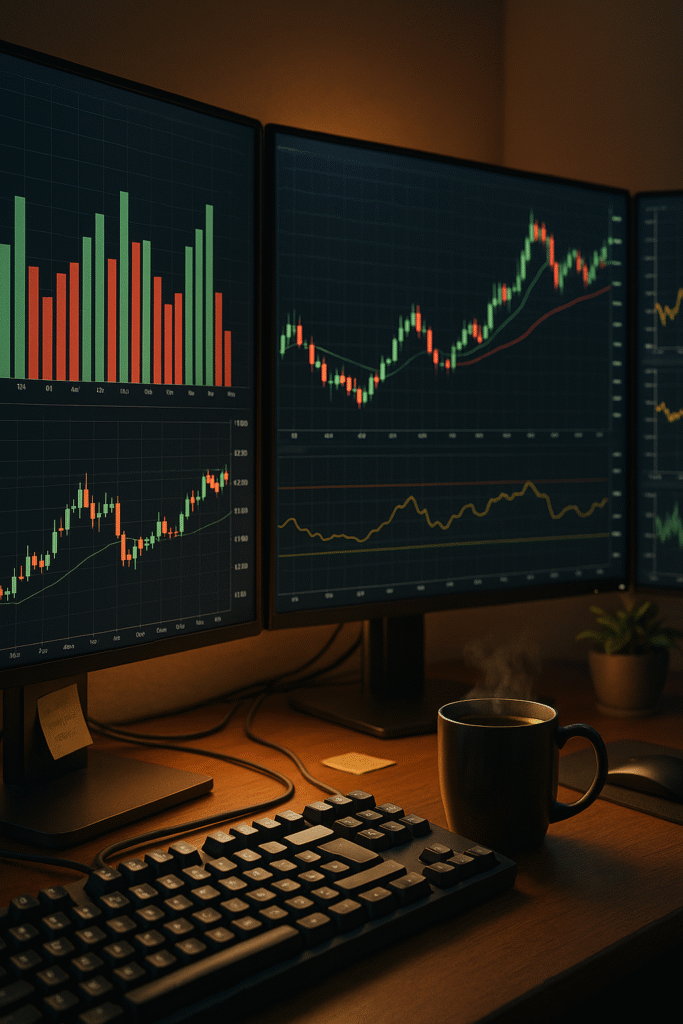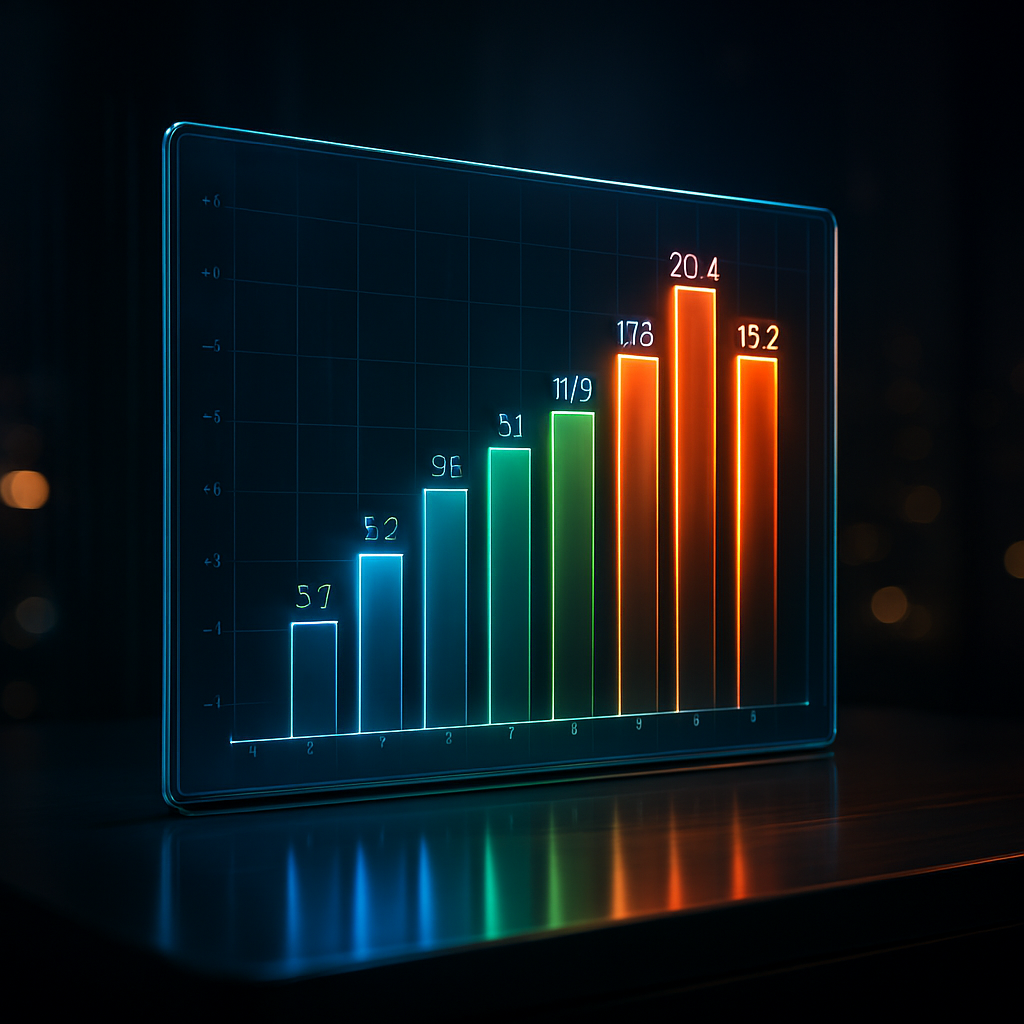
- What Are Investing Charts and Why They Matter in Today’s Market
- The Basics — How to Read Investing Charts Like a Pro (Even if You’re a Beginner)
- Types of Investing Charts Explained Simply
- TradingView Charts: The Modern Standard for Investors
- Investing Charts for Long-Term vs. Short-Term Investors
- Best Tools and Apps to Access Free Investing Charts Online
- Comparison: TradingView, Investing.com, Yahoo Finance, and Google Finance
- How to Choose the Right Charting Platform
- FAQs About Investing Charts
- 1. What are investing charts?
- 2. What are the main types of investing charts?
- 3. Which chart is best for beginners?
- 4. How can I learn to read charts faster?
- 5. Are investing charts reliable for decision-making?
- 6. Is TradingView better than other charting apps?
- 7. What’s the difference between investing and trading charts?
- Conclusion — Mastering Investing Charts is Easier Than You Think
If you’ve ever looked at an investing charts and felt lost in a jungle of lines, candles, and patterns — you’re not alone. For beginners, charts can seem intimidating. But once you understand how to read and use them, these visuals become one of your most powerful tools in investing.
In simple terms, investing charts are graphical representations of how a stock, index, or asset performs over time. They help investors visualize price movement, identify market trends, and make informed decisions rather than relying on luck or social media tips. Whether you’re analyzing a company’s stock or exploring crypto trends, learning how to read investing charts gives you an edge that separates beginners from confident investors.
Today, online platforms like TradingView charts and Investing.com have made technical analysis accessible to everyone — not just professional traders. You can see live market data, draw trend lines, and analyze candlestick patterns right from your laptop or phone.
What Are Investing Charts and Why They Matter in Today’s Market

Before you start analyzing numbers or searching for the next big stock, it’s crucial to understand what investing charts actually are. At their core, investing charts are visual representations of price movement over time — they show how a particular stock, mutual fund, or index performs in the market.
Think of an investing chart as the heartbeat of a company’s stock. Every rise or dip tells a story — about investor sentiment, demand, supply, or even breaking news. When you learn how to read investing charts, you begin to interpret these movements, almost like reading between the lines of market psychology.
The Purpose of Investing Charts
An investing chart helps you track:
- Price trends — whether a stock is moving upward (bullish), downward (bearish), or sideways (neutral).
- Volume activity — showing how many people are buying or selling.
- Momentum shifts — identifying when enthusiasm or fear takes over the market.
These insights make charts an indispensable part of technical analysis, a method investors use to forecast future price movement based on historical data. Unlike balance sheets or profit statements, which reflect a company’s past performance, charts show real-time investor behavior — giving you clues about what might happen next.
Why Investing Charts Matter More Than Ever

In today’s fast-paced financial world, relying on gut feeling isn’t enough. Markets move quickly — sometimes in seconds — and investing charts give you the speed and clarity to act smartly.
Platforms like TradingView charts have made this even easier, offering live visuals, real-time updates, and interactive tools that were once available only to professionals. Whether you’re an investor checking long-term performance or a short-term trader looking for opportunities, charts simplify decision-making by turning data into patterns you can actually see.
For example:
- A steady upward trend might indicate consistent investor confidence.
- A sharp dip could signal panic or an overreaction.
- A candlestick pattern might reveal whether buyers or sellers are in control.
Understanding these patterns doesn’t just make you a smarter investor — it makes you a more confident one. You start noticing details others overlook, helping you time your entries, exits, and investments with better precision.
The Basics — How to Read Investing Charts Like a Pro (Even if You’re a Beginner)

If you’re new to the world of investing, reading an investing chart can feel like deciphering a secret code. Lines go up and down, candles change colors, and the data seems endless. But once you understand the building blocks, it all starts to make sense — and even becomes exciting.
Learning how to read investing charts is like learning to read a map. It doesn’t tell you exactly where the market will go, but it gives you a direction — helping you spot potential turns, trends, and opportunities before everyone else.
Let’s break it down step by step 👇
1. Understanding the Axes — Price, Volume, and Time
Every investing chart is built on two main axes:
- The Vertical Axis (Y-axis) shows the price of the stock or asset.
- The Horizontal Axis (X-axis) represents time — it could be days, weeks, or months.
This simple layout lets you see how a stock’s price has moved over time. For example, if a company’s stock has been trending upward for months, you can visualize that long-term growth right on the chart.
Below the price chart, you’ll often notice colored bars — that’s trading volume. High volume usually means strong market interest or a big event (like earnings announcements), while low volume signals quiet market activity.
2. Spotting Trends — The Language of Market Movements
One of the most important things to learn from investing charts is how to recognize trends.
- An uptrend shows higher highs and higher lows — meaning investors are confident and buying.
- A downtrend shows lower highs and lower lows — meaning sellers are dominating.
- A sideways trend means the market is in balance — neither buyers nor sellers have control.
By understanding these movements, you’ll start to predict when momentum shifts and when to buy or sell.
💡 Pro Tip: Most beginners find TradingView charts helpful for spotting trends visually. They offer clean layouts and tools like trend lines that make it easy to see where the market is headed.
3. Reading Chart Elements — Lines, Bars, and Candles
Each investing chart uses a different visual style to show data. The most common are:
- Line Charts: The simplest form, connecting closing prices over time. Ideal for beginners and long-term investors.
- Bar Charts: Show opening, closing, high, and low prices for a given time period. Great for those who want more detail.
- Candlestick Charts: The most popular among traders — they display market sentiment using color and shape. Green (or white) candles often show buying strength, while red (or black) candles indicate selling pressure.
Once you learn what these shapes and colors mean, you can read an investing chart in seconds — spotting whether the market feels optimistic or fearful.
4. Using Timeframes — Zooming In and Out of the Market
Charts can display data across multiple timeframes:
- Intraday charts (minutes or hours) are for short-term traders.
- Daily or weekly charts are for medium-term investors.
- Monthly or yearly charts are ideal for long-term investors looking for consistent growth.
Switching between these timeframes gives you a clearer picture — helping you align short-term movements with long-term trends.
5. Practice Makes Perfect
Reading investing charts is a skill that improves with practice. Start small — pick a few stocks, open their charts on TradingView, and observe how prices react to news or earnings.
You’ll soon notice patterns, recognize recurring shapes, and develop an instinct for when the market might change direction.
Types of Investing Charts Explained Simply

When it comes to chart-based investing strategy, understanding different types of investing charts is the foundation. Charts are visual tools that show stock price movement analysis, trading volume, and market trends visualization. While there are many advanced charting methods, beginners should start with the three most common formats: line charts, bar charts, and candlestick charts.
Each chart type serves a different purpose — from simple financial data interpretation to in-depth technical stock charts analysis. Let’s break them down one by one.
Line Charts — Simple and Effective for Beginners

What is a line chart?
A line chart is the most basic form of an investing chart. It connects closing prices over a set period, forming a simple line that helps beginners understand stock performance over time.
Why it’s useful:
- Great for chart reading for beginners.
- Shows clear trends without overwhelming details.
- Ideal for long-term stock price movement analysis.
Best use case:
Line charts are perfect for investors who want a beginner trading guide or for those who just want to track market trends visualization without getting into technical details.
Tip: If you’re learning how to read investing charts step by step, start with line charts. They give a clean view of whether a stock is trending upward, downward, or moving sideways.
Bar Charts — For Intermediate Readers and Analysts

What is a bar chart?
A bar chart adds more detail compared to line charts. Each bar represents a trading period (daily, weekly, monthly) and shows open, high, low, and close (OHLC) prices.
Why it’s important:
- Provides deeper financial data interpretation.
- Helps traders identify trend lines and price patterns.
- Useful for chart analysis with more context.
Comparison with candlestick charts:
Many beginners ask: What’s the difference between candlestick and bar charts?
- Bar charts display OHLC using vertical lines and horizontal ticks.
- Candlesticks use body + wicks, making trends visually easier to spot.
Best use case:
Bar charts are preferred by intermediate traders who want more than just trend direction — they want to understand price volatility and investor behavior.
Candlestick Charts — The Favorite Tool of Traders

What is a candlestick chart?
A candlestick chart is the most popular tool among traders and is widely used in TradingView charts. Each candlestick shows open, high, low, and close prices — but in a way that’s highly visual.
Why traders love it:
- Candles are color-coded (green for gains, red for losses).
- Easy to recognize investing chart patterns like Doji, Hammer, or Engulfing.
- Simplifies spotting support and resistance levels.
How it helps beginners:
- Beginners often search for “how to analyze stock charts for beginners” — candlestick charts make this easier because patterns are visually clear.
- Perfect for learning volume indicators, trend lines, and moving averages in real trading.
Best use case:
Candlestick charts are ideal for both beginners and professionals who want quick chart analysis. Whether you’re looking for short-term trading signals or long-term trends, candlesticks give a powerful, detailed picture.
TradingView Charts: The Modern Standard for Investors

When it comes to online investing tools, nothing matches the popularity of TradingView charts. For both beginners and professional traders, TradingView offers advanced features that make chart analysis simple yet powerful. Whether you’re trying to understand stock price movement analysis or want to apply advanced technical stock charts, TradingView is the modern standard.
Why TradingView is the best for investors:
- Real-time market trends visualization.
- Dozens of chart types including line, bar, and candlestick charts.
- Built-in tools like trend lines, moving averages, and volume indicators.
- Easy sharing and community-driven chart-based investing strategies.
If you’ve ever wondered “which type of chart is best for trading?” — TradingView lets you test them all in one platform.
Setting Up Your First Chart on TradingView
If you’re a beginner asking, “how to read stock charts for beginners?”, TradingView makes the process straightforward.
Step-by-step guide to your first chart:
- Create a Free Account – Sign up with email or Google.
- Search for a Stock/Index – Example: AAPL, NIFTY 50, or Bitcoin.
- Select Chart Type – Choose between line charts, bar charts, or candlestick charts.
- Add Indicators – Apply moving averages, volume indicators, or trend lines to start your analysis.
- Customize Timeframes – Switch from 1-minute to 1-day or even monthly charts depending on your strategy.
Pro Tip: For chart reading for beginners, start with a line chart to learn basics, then progress to candlestick charts as you practice recognizing investing chart patterns.
Reading Live Investing Charts Online
One of TradingView’s strongest features is access to live investing charts. This helps you analyze stock price movement in real time, unlike static charts you find in newspapers or basic broker platforms.
Benefits of live charts:
- Real-time updates on price patterns.
- Ability to spot short-term market trends visualization.
- Easier to practice chart-based investing strategy by testing trades virtually.
How to use live charts effectively:
- Track support and resistance levels during market hours.
- Use volume indicators to confirm whether a breakout is real.
- Combine trend lines and moving averages to identify strong entry or exit points.
Beginner takeaway: If you’re learning “how to analyze stock charts for beginners”, live charts on TradingView give you the perfect playground to practice without risking real money.
Investing Charts for Long-Term vs. Short-Term Investors

One of the most important aspects of chart-based investing strategy is understanding that not all investors use the same charts. A long-term investor analyzing weekly or monthly charts will interpret market data differently than a short-term trader who studies intraday and daily stock charts.
The choice of timeframe directly impacts how you read price patterns, moving averages, and trend lines. While long-term investors focus on market trends visualization, short-term traders rely on quick chart analysis and live investing charts to capture immediate price movement.
Long-Term View: Weekly and Monthly Charts
Why use long-term charts?
Weekly and monthly investing charts are best for investors who care about bigger market trends rather than daily fluctuations. They help in long-term financial data interpretation and guide portfolio decisions over months or years.
How long-term investors read charts:
- Focus on major trend lines (uptrend or downtrend).
- Use moving averages (50-day, 200-day) to confirm direction.
- Identify strong support and resistance levels.
- Look for larger investing chart patterns like double bottoms, head & shoulders, or market cycles.
Best for:
- Retirement planners.
- Value investors holding stocks for years.
- Beginners asking “how to understand investing charts simply” but who prefer a less stressful, big-picture approach.
👉 Example: A long-term investor might use a monthly candlestick chart to see whether a company has consistently grown over 5 years before buying.
Short-Term View: Intraday and Daily Charts
Why use short-term charts?
Daily and intraday stock charts are crucial for traders who seek quick profits. These charts, especially on TradingView, update in real-time, helping traders capture opportunities within hours or minutes.
How short-term traders read charts:
- Rely on candlestick charts for spotting micro-patterns.
- Use volume indicators to confirm breakouts.
- Track moving averages (5-day, 20-day) for momentum.
- Apply tools like trend lines to predict intraday reversals.
Best for:
- Day traders and swing traders.
- Active investors who rely on technical stock charts.
- Learners searching “how to analyze stock charts for beginners” in a real-time environment.
👉 Example: A trader may use a 15-minute bar chart to decide whether to enter or exit a position within the same trading session.
🔑 Key Difference:
- Long-term charts = focus on macro trends (slow, steady growth or decline).
- Short-term charts = focus on micro movements (daily volatility, quick entry/exit).
Both approaches use the same tools — candlesticks, volume indicators, trend lines, and moving averages — but the time horizon changes the strategy entirely.
Best Tools and Apps to Access Free Investing Charts Online

Understanding how to read investing charts is one of the most valuable skills for anyone serious about building wealth through the stock market. Whether you’re a beginner investor or an experienced trader, the ability to interpret stock charts, identify price patterns, and spot market trends can give you a major edge.
Fortunately, there are many free online investing chart platforms that make this process accessible and interactive. Let’s explore the best tools and apps for stock chart analysis, compare their features, and help you choose the one that fits your style of investing.
Comparison: TradingView, Investing.com, Yahoo Finance, and Google Finance
1. TradingView — The Most Advanced Free Charting Tool
TradingView is widely considered the gold standard for online trading view charts. It combines professional-level features with a user-friendly interface that appeals to beginners and advanced investors alike.
Key Features:
- Offers multiple types of stock charts, including line charts, bar charts, and candlestick charts.
- Real-time market data, custom alerts, and hundreds of technical indicators.
- Drawing tools for trend lines, moving averages, volume indicators, and chart patterns.
- A social community where traders share insights, chart analysis, and strategies.
Best For:
Traders and investors who want detailed technical stock charts and community learning.
SEO Tip: If you’re learning how to analyze stock charts for beginners, TradingView’s free plan is an excellent place to start. You can learn how to read investing charts step by step using their interactive features.
2. Investing.com — Global Markets and Comprehensive Data
Investing.com is ideal for investors who want to connect technical charting with global economic insights. Beyond just stock charts, it offers commodity, crypto, and forex charts, making it one of the most versatile platforms for market trend visualization.
Key Features:
- Multiple types of investing charts (daily, weekly, monthly).
- Dozens of technical indicators for deeper price pattern recognition.
- Economic calendar integration for correlating events with stock price movement analysis.
- Tools for chart-based investing strategies and portfolio monitoring.
Best For:
Investors who value financial data interpretation alongside technical stock chart analysis.
3. Yahoo Finance — Perfect for Chart Reading Beginners
Yahoo Finance remains a favorite among those just getting started. It offers clean, simple charts and basic technical stock chart options.
Key Features:
- User-friendly line, bar, and candlestick charts.
- Visual display of moving averages, volume indicators, and trend lines.
- Integration with watchlists and portfolios for easy tracking.
- Great educational resource for chart reading for beginners.
Best For:
Beginners who want to learn how to understand investing charts without being overwhelmed.
Pro Tip: Yahoo Finance’s “Full Screen Chart” mode allows users to practice price pattern identification while studying real-time data.
4. Google Finance — Quick and Simple for Market Monitoring
Google Finance offers a minimalist charting experience but is perfect for quick reference and learning the basics of market trends visualization.
Key Features:
- Easy navigation with simplified line charts and bar charts.
- Instant access to company financials, market news, and stock price movement.
- Ideal for beginner trading guides and step-by-step learning.
Best For:
Casual investors who want to get familiar with investing charts explained simply before moving to advanced tools like TradingView.
How to Choose the Right Charting Platform

Choosing the right charting platform depends on your skill level, trading goals, and how deeply you want to dive into technical analysis.
Here’s what beginners should look for when selecting a charting app:
- Ease of Use:
Look for platforms with clear navigation and basic types of investing charts (line, bar, candlestick). Complicated tools can slow your progress early on. - Educational Resources:
The best platforms include tutorials on how to read investing charts and how to identify stock chart patterns. - Technical Indicators:
Even if you’re a beginner, choose a platform that includes trend lines, moving averages, and volume indicators — these are essential for chart analysis and price pattern recognition. - Customization:
Tools like TradingView allow you to save layouts and customize your technical stock charts, which can be valuable as you develop your chart-based investing strategy. - Data Accuracy and Speed:
Reliable real-time data ensures your stock price movement analysis reflects true market trends, not delayed information.
Ultimately, beginners should start simple with Yahoo Finance or Google Finance, and as their confidence grows, transition to Investing.com or TradingView for more sophisticated analysis.
FAQs About Investing Charts

1. What are investing charts?
Investing charts are graphical representations of stock price movements over time. They visualize how a stock’s price changes daily, weekly, or monthly and help investors identify market trends and price patterns.
By studying these patterns, investors can make informed decisions about when to buy or sell stocks, forming the foundation of chart-based investing strategies.
2. What are the main types of investing charts?
The three primary types of investing charts are:
- Line Charts:
The simplest form, showing only closing prices over time. Ideal for beginners learning how to read stock charts for beginners. - Bar Charts:
Show the opening, closing, high, and low prices for each time period. Useful for short-term stock trend analysis. - Candlestick Charts:
The most popular among traders, combining price information with color-coded candles that reflect market sentiment.
If you’ve ever wondered about the difference between candlestick and bar charts, candlesticks provide more visual clarity on price direction, while bar charts offer a minimalist view of price fluctuations.
3. Which chart is best for beginners?
For those new to investing, line charts are the best starting point. They’re clean, easy to understand, and give a straightforward overview of market trends visualization.
As you advance, move to bar and candlestick charts to identify complex price patterns and refine your technical stock chart analysis.
4. How can I learn to read charts faster?
Learning chart reading for beginners doesn’t have to take years. Follow these steps to accelerate your progress:
- Start with line charts to understand basic trends.
- Practice drawing trend lines and identifying support and resistance levels.
- Learn key volume indicators and moving averages.
- Study chart patterns like double tops, triangles, and flags.
- Use TradingView charts daily — consistency builds familiarity.
With steady practice, you’ll soon be able to spot investing chart patterns almost instinctively.
5. Are investing charts reliable for decision-making?
Investing charts are highly useful but not 100% predictive. They show historical price patterns and market sentiment, allowing you to forecast potential movements. However, chart analysis should always be paired with fundamental research — such as company earnings, news, and economic factors — for reliable investment decisions.
6. Is TradingView better than other charting apps?
TradingView stands out for its advanced features, social community, and smooth interface. It’s especially popular among those who actively practice chart-based investing strategies.
However, for absolute beginners, Yahoo Finance or Investing.com may feel less intimidating while still providing powerful tools for financial data interpretation.
7. What’s the difference between investing and trading charts?
The main difference lies in timeframe and purpose:
- Investing charts are used for long-term market trends visualization to guide buy-and-hold decisions.
- Trading charts focus on short-term price patterns for quick buy-sell actions.
Understanding both helps investors adapt their approach based on goals — long-term wealth building or short-term profit-taking.
Conclusion — Mastering Investing Charts is Easier Than You Think
At first glance, investing charts might seem intimidating — filled with candles, bars, and lines. But once you understand how to interpret trend lines, moving averages, and price patterns, it becomes one of the most empowering skills in investing.
Start small:
- Use Google Finance or Yahoo Finance to grasp the basics.
- Graduate to TradingView or Investing.com for deeper chart analysis.
- Practice daily and learn how to read investing charts step by step.
In time, you’ll transform data into insight and make confident, informed decisions using your own chart-based investing strategy.
Remember — every successful investor once asked, “What are stock charts, and how do they work?” The difference is that they took the time to learn. You can too.


Leave a Reply